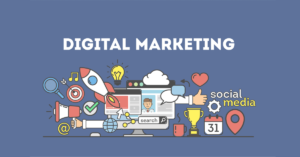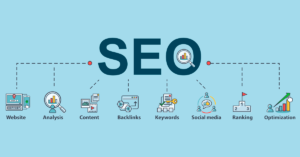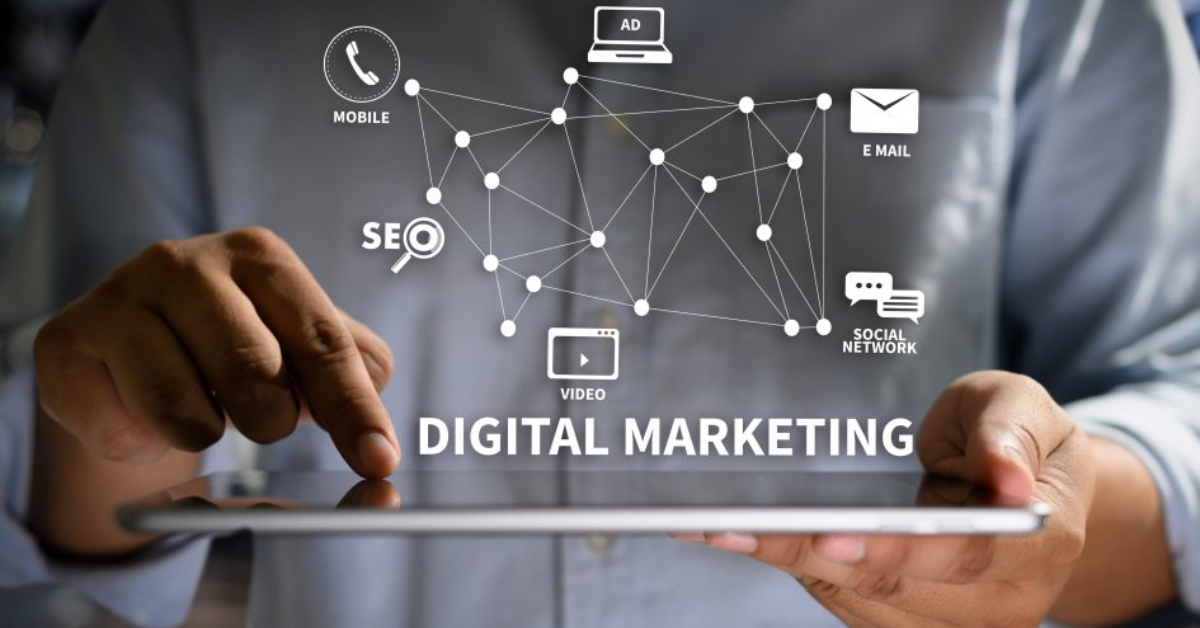Learn about the latest trends and develop your own digital marketing strategy to optimize advertising on websites, social media, email, mobile applications, and search engines.
The word “digital marketing” is broad and covers a variety of topics, including blog authorship, distribution channels, budgeting, and SEO. By comprehending the key tenets of digital marketing, which we’ll help you achieve in this video, you may develop your own digital marketing strategy to optimize advertising through online channels including search engines, your websites, social media, email, and mobile apps.
What is Digital marketing ?
Digital marketing, often known as online marketing, is the technique of distributing advertisements over the internet and other digital media to connect brands with potential clients.
- search engines
- Websites
- on social media
- mobile programmes
- composing texts
- marketing on the internet
Briefly put, digital marketing is any marketing initiative that makes use of any of the aforementioned online media channels.
A large portion of modern consumers’ product research is done online. 77% of buyers purchase a brand online before connecting with it, according to HubSpot Research. Despite the fact that 51% of consumers claim to do product research on Google before making a purchase.
Read Here: Revolutionizing Education: The Impact of EdTech on Learning
How Does Online Marketing Work?
Whether the goal is to convince customers to make a purchase, raise their brand knowledge, or simply engage them with your brand, digital marketing employs a variety of tactics to get in touch with customers. Modern digital marketing encompasses a large network of outlets, including:
- on social media
- content marketing
- websites are promoted
- SEO (search engine optimization) (search engine optimization) optimization for search engines
- PPC (pay-per-click) marketing
To fully utilize digital marketing, marketers must go deeply into the vast and complex cross-channel world of today to identify engagement marketing methods.

Engagement marketing is a strategy for creating lasting connections with potential and loyal customers based on the information you accumulate over time. By communicating with customers online, you may raise brand awareness, position yourself as an industry leader, and draw attention to your business when a customer is ready to make a purchase.
Why is digital marketing important?
Utilizing an omnichannel digital marketing strategy offers the way for fresh approaches to customer involvement while giving businesses useful information on the habits of their target market.
Additionally, businesses might expect a gain in retention. According to an Invesp survey, companies that employ successful multichannel customer engagement strategies often retain 89% of their customers.Companies with subpar omnichannel strategy, on the other hand, only have a 33% retention rate.
It’s a new field, digital marketing. For instance, the expanding selection of wearable technologies that clients can choose from gives fresh marketing possibilities. Forbes predicts that email marketing will become increasingly more personalized and that video material will be enhanced for SEO (SEO).
“Digital has changed from being “one of the things marketing does” to “THE thing that marketing does,” and it now serves as the cornerstone for all aspects of contemporary marketing.”
(Former Marketo Chief Marketing Officer Sanjay Dholakia)
B2B and B2C marketing’s contrasts.
You’ve probably heard of B2B and B2C, but do you know how they differ from one another? Business-to-business (B2B) and business-to-consumer (B2C) are two distinct marketplaces that require separate marketing strategies.
Messages and language.
Instead of marketing to consumers and customers, B2C is focused on communicating with other businesses and conducting business with them.
For instance, when it comes to B2B marketing, you’re more likely to focus on a message that informs your potential clients while utilizing formal language and industry jargon. Attracting customers, increasing brand recognition, and crafting an engaging story may be the primary goals of B2C marketing.
Decision-making.
The method by which judgements are made is yet another crucial distinction. A customer’s decision to buy from you could be made quickly using B2C. Naturally, to get their trust in digital marketing, you must first gain it.
However, decisions are frequently made by a solitary individual, particularly in the retail sale of commodities like apparel or kitchenware. Expenses that are more expensive, such as travels, can make things more difficult. However, the purchasing process is simpler and faster.
When implementing B2B marketing, a corporation may need to persuade a variety of stakeholders. For instance, you can be competing with other service providers while directly selling building materials to important construction companies.
Knowing your target demographic and adjusting your marketing strategy accordingly are ultimately the most crucial factors.
Read Here: BharOS: A User-Friendly Operating System for Seamless Computing Experience
The Advantages of Online Marketing.
You may use digital marketing to understand your audience better, gather important data about them, and provide analytics that will show how skilled your marketing team is. Among the advantages of digital marketing are the following:
- You will get to know your audience.
Digital marketing is the best method for getting to know and interacting with your audience. To find out when website visitors are most likely to arrive, experiment with promotions and messages. You might be able to develop relationships with them more quickly and simply if you have a social media plan, which is something you should have without a doubt.
- The cost is affordable.
Compared to traditional marketing tactics, digital marketing is less expensive. There are fewer costs involved. You can create social media accounts for nothing by joining up with a provider of email newsletters at a fair price. Due to its relative price, digital marketing is acceptable for even the smallest businesses.
- Marketing may be used to reach anyone, everywhere.
You have a huge potential audience with digital marketing. Customers in various time zones can be reached just as easily as if you were placing an advertisement in your neighbourhood newspaper (easier, in fact).
Your business has the potential to grow in previously unimaginable ways, and your market reach can be increased.
- It is possible to change digital marketing.
You can be quick, adaptable, and nimble in your approach when using digital marketing. Try out several strategies, assess the outcomes, and try something fresh the following month—or week. Instead of waiting weeks to see the effects of a campaign, have access to real-time data to assist guide your company’s actions.
- There is a choice for channel customisation.
Your marketing must have cross-channel skills from teams with a variety of skill sets in order to reach customers where they are at that precise moment. For instance, since each social media platform has a different set of users and expectations, marketing may appear differently there. This includes the tone, visuals, offers, and timing of your article.
- There are options for establishing KPIs and assessing campaigns.
You may assess the success of your campaign using a variety of metrics that digital marketing offers. Identifying your goals and ideal metrics for each channel should be your first step. You can track the number of leads and conversions, website views, and much more, giving you a wealth of data that can aid in the expansion of your firm.
Digital Marketing Variations.
Digital marketing enables customers to interact with a large network of digital touchpoints during the course of a typical day. Understanding each of these routes is necessary for effective utilisation.
Pay-per-click.
One typical type of paid search is pay-per-click (PPC) advertising, which is typically referred to as the sponsored result at the top or side of a search engine results page (SERP). These advertising can be set up to charge you for each click and appear when certain search terms are entered.

Advantages.
In essence, your ads are seen by those who are looking for a particular good or service. These advertising can therefore be highly effective because they make use of data gleaned from users’ online activity and are used to boost website traffic by displaying pertinent advertisements to the right people at the right time. Additionally, the use of retargeting in these ads enables marketing automation tools to provide precise, customized cross-platform ads in response to consumer activity.
Disadvantages.
The negatives of PPC include effort and expense. Even if you are free to spend your money anyway you like, expenses can add up quickly. Campaigns frequently need monitoring and optimization, which adds to the time investment.
Search Engine Optimization (SEO).
The act of improving a website’s technical setup, content, and accessibility such that its pages show up at the top of a search engine result page for a certain set of keyword terms is known as SEO.

Advantages.
Search rankings and, by extension, organic site traffic are significantly impacted by SEO-generated organic online traffic. By utilising keywords and phrases, SEO may be used to greatly increase visibility and establish a long-lasting client relationship. SEO is the practise of improving a website’s position in online search results and, as a result, its organic site traffic by using well-known keywords and phrases. Strong SEO techniques are crucial in digital marketing activities because visibility is the first step in developing a long-lasting customer relationship.
Disadvantages.
Patience is necessary because it could take some time for an SEO strategy to start working for your website. Google algorithm updates could affect your rankings, which can need changing how you go about things.
Promotion of Content.
Instead of being blatantly commercial in nature, effective content marketing aims to inform and motivate information-seeking consumers. You may become recognized as a thought leader and a reliable information source when you provide content that is pertinent to your audience.

Advantages.
Writing blog articles, how-to manuals, whitepapers, or any other type of content for material marketing is well worth the extra effort because it produces three times as many leads as paid search advertising.
Disadvantages.
Numerous businesses struggle with locating the resource, developing a differentiator from the competition, and maintaining momentum.
Social Media Promotion.
Your business needs to be active on a lot of different social media channels due to how prevalent social media is. However, effective social media marketing involves more than just having a few social media profiles.

Advantages.
The more engaged your audience is with your content, the more likely it is that they will share it and possibly even convince their friends to buy your products, therefore you must use social media platforms intelligently and effectively.
Disadvantages.
Since what works on one platform, like Twitter, might not work as well on another, like Instagram, which is more visual, it is crucial to alter your content across platforms. Businesses using social media typically make the mistakes of not publishing frequently enough or posting inanely.
Email promotion.
After more than 20 years, email is still the quickest and most direct way to communicate critical information to clients. Great email marketing requires being extremely engaging, relevant, instructive, and entertaining in order to avoid being buried in your clients’ inboxes.
To be successful, your marketing emails must adhere to five crucial requirements. They must be:
- Trustworthy
- Relevant
- Conversational
- synchronized between channels
- Strategic
Timing is everything; if you repeatedly give customers things that are irrelevant or repetitious, they can hit the unsubscribe button.
Mobile Advertising.
Our mobile devices are kept in our pockets, placed next to our mattresses, and checked regularly during the day. However, mobile marketing is also highly complicated due to its close-knit nature.
Advantages.
While SMS, MMS, and in-app marketing are all great ways to reach your clients, you should also consider coordinating your marketing efforts across all of your digital marketing platforms.
Disadvantages.
Given that privacy is still an issue, carefully consider how you handle client data.
Automation in Marketing.
Marketing automation is the platform that links everything to your digital marketing. Businesses that automate lead management really see a 10% or more increase in income within the first six to nine months. Your campaigns will resemble a puzzle with a missing piece if you don’t have it.
Software for marketing automation
- simplifies the activities and workflow in marketing
- measuring of results
- determines the return on investment for your digital advertising.
Using marketing automation can help you discover a lot about which efforts work and which don’t. It will also provide data so you can show how digital marketing has affected the bottom line of your company.
Read Here: Telegram’s Privacy Claims Put to the Test: A Review of the App in 2023
Jobs in Digital Marketing.
Although some of the jobs and tasks in the digital marketing industry complement one another, they all require different skill sets and personality attributes. In digital marketing, important positions include:
- SEO.
In charge of devising a data-based strategy to improve rankings, reviewing the performance of websites, benchmarking against competitors, and search engine optimization.
- Content.
including copywriters to create content for websites and strategists to organize things like campaign calendars and blog posts.
- On social media
scheduling events, producing content for various social media channels, and responding to client feedback.
- PPC.
Managing pay-per-click advertising programmes involves setting spending limits and budgets, keeping track of performance, and recommending new tactics.
- Lead Generation.
creating new leads for the business, whether through managing an outbound strategy or responding to incoming queries.
- ROI of a productive digital marketing campaign.
Digital marketing’s ROI (return on investment) is far broader than the upfront payment of conventional banner ads.
- Digital marketing communicates with people in ways other than ads.
Approximately 70% of internet users prefer reading product-related material over watching conventional adverts (MDG, 2014).
- Digital marketing serves as the gasoline for content marketing.
The top five B2B content marketing techniques include social media content (92%), e-newsletters (83%), website articles (81%), blogs (80%), and in-person events (77%) (source).
- Digital marketing is primarily reliant on SEO.
32.5% of all traffic for a given search keyword goes to Google’s first organic search results (Chitka)
How To Organize, Carry Out, And Improve Your Digital Marketing Strategy.
Determine your target demographic and goals before beginning your digital marketing strategy. Then, create metrics to track your success.
- Determine and classify your target audiences
Modern consumers expect a customized experience at every touchpoint. You must understand their firmographic, technographic, and demographic characteristics in order to accomplish this, as well as how to respond to their concerns and pain areas.
- Create goals and a strategy for measuring success.
Create personas based on information about your audience in order to fully comprehend your audience’s sales journey and to set your goals and measurement strategy.
Important metrics include:
- Impressions
- Click-through rates on Reach’sClicks (CTR)
- engagement conversion rate
- Cost per thousand impressions effective (CPM) Lead price (CPL) (eCPM)
The lifetime value of a customer, first- and multi-touch attribution, return on investment, and return on advertising spend (ROAS) are further back-end measures (LCV).
- Set up your AdTech and channels.
Before you start, make sure you have all the tools you need because understanding ad technology can be time-consuming. These elements consist of:
- data management based on a platform (DMPs)
- platform-based demand-side systems (DSPs)
- platforms for supply-side trading exchanges (SSPS)
Bring your team together, go over everyone’s objectives, and show how each person’s channel fits into the bigger picture of digital marketing.
- Begin, then get better.
Branding, patronage, nurturing, and acquisition are all purposes for which digital marketing can be employed. In order to position yourself as a leader in this high-impact, high-demand sector, review metrics periodically to determine your areas of strength and progress.
